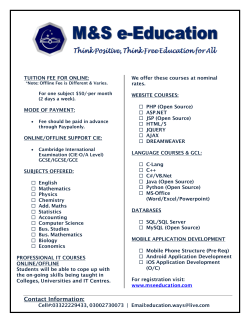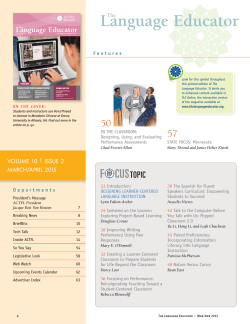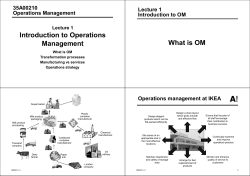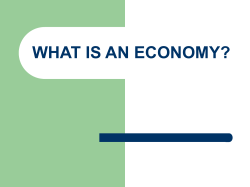
Sunarto Prayitno 1
Sunarto Prayitno 1 The fundamental of business strategy – seeking competitive advantage based on superior value, building unique resources, and positioning in the minds of customers. 2 American Marketing Association definition of marketing: Marketing is the process of planning and executing the conception, pricing, promotion, and distribution of ideas, goods, and services to create exchanges that satisfy individual and organizational goals. (The AMA’s Dictionary of Marketing Term, 1985) 3 Marketing is a process: The classical marketing approaches: 1. Market Analysis 2. Market Planning 3. Implementation 4. Control 4 Involves of marketing mix (Four Ps): 1. Product 2. Pricing 3. Promotion 4. Distribution 5 Exchange something of value: In terms of marketing, the product or offering will be successful if it delivers value and satisfaction to the target buyer. Value is a ratio between what the customer gets and what he gives. Benefits Value = -------------Costs 6 Satisfy individual and organizational needs: The key to modern marketing is simultaneously satisfying the customer, the firm, and its stakeholders. In the long run, the firm must have a positive cash flow or show a clear path to profitability for investors to maintain confidence. 7 Marketing is an organizational function and a set of processes for creating, communicating and delivering value to customers and for managing customer relationship in ways that benefit the organizational and its stakeholders. (American Marketing Association, 2004) 8 Internet (interactive) marketing is the process of building and maintaining customer relationships through online activities to facilitate the exchange of ideas, products, and services that satisfy the goals of both parties. (Imber, Jane, and Betsy-Ann Tofler, 2000) 9 Building and maintaining customer relationships: Make a loyal customers. Relationships: Awareness, exploration, and commitment. Building relationships with online customers. 10 The internet marketing program may well be part of a broader campaign to satisfy customers who use both online and offline services. 11 Online: By definition, internet marketing deals with levers that are available in the world of the internet. However, the success of an internet marketing program may rest with traditional, offline marketing vehicles. 12 Exchange: The core of marketing program is the concept of exchange. Satisfaction of goals of both parties: The key to modern marketing is simultaneously satisfying the customer, the firm, and its stakeholders. 13 A process of interactive marketing (the seven stages): Framing the market opportunity. Formulating the marketing strategy. Designing the customer experience. Crafting the customer interface. Designing the marketing program. Leveraging customer information through technology. Evaluating the results of the marketing program as a whole. 14 1. Framing the Market Opportunity: Stage one involves the analysis of market opportunities and an initial first pass of the business concept – that is, collecting sufficient online and offline data to establish the burden of proof of opportunities assessment. 15 2. Formulating the Marketing Strategy: Internet marketing strategy is based upon corporate, business-unit, and overall marketing strategy of the firm. The marketing strategy goals, resources, and sequencing of actions must be tightly aligned with the business-unit strategy. Finally, the overall marketing strategy include both offline and online marketing activities. 16 3. Designing the Customer Experience: Firm must understand the type of customer experience that needs to be delivered to meet the market opportunity. The experience should correlate with the firm’s positioning and marketing strategy. Thus, the design of the customer experience constitutes a bridge between the high-level marketing strategy and the marketing program tactics. 17 4. Crafting the Customer Interface: The internet has shifted the locus of exchange from the marketplace (face-to-face interaction) to the marketspace (screen-to-face interaction). The key difference is that the nature of the exchange relationship is now mediated by a technology interface. This interface can be a desktop PC, sub-notebook, personal digital assistant, mobile phone, wireless applications protocol (WAP) device, or other internetenabled appliance. 18 5. Designing the Marketing Program: Stage five entails designing a particular combination of marketing actions (termed levers) to move target customers from awareness to commitment. The frame work used to accomplish this task is the Marketspace Matrix. Simply put, the internet marketer has six classes of levers (product, pricing, communication, community, distribution, and branding) that can be used to create target customer awareness, exploration, and it is hoped, commitment to the firm’s offering. 19 6. Leveraging Customer Information Through Technology: In a customer-centric environment, firms have to make and act on three key decisions: (1) Strategically select what markets to pursue (marketing research); (2) Learn more about customers and device strategies to acquire target customers (database marketing); and (3) Assess the long-term profitability of customers and retain key customers (customer relationship management/CRM). 20 Firms can use technology to obtain, organize, analyze, and utilize customer-relevant information, which can reduce the uncertainty associated with each of the three major types of decisions. 21 7. Evaluating the Marketing Program: This last stage involves the evaluation of the overall internet marketing program. This includes a balance focus on both customer and financial metric. 22
© Copyright 2025





















